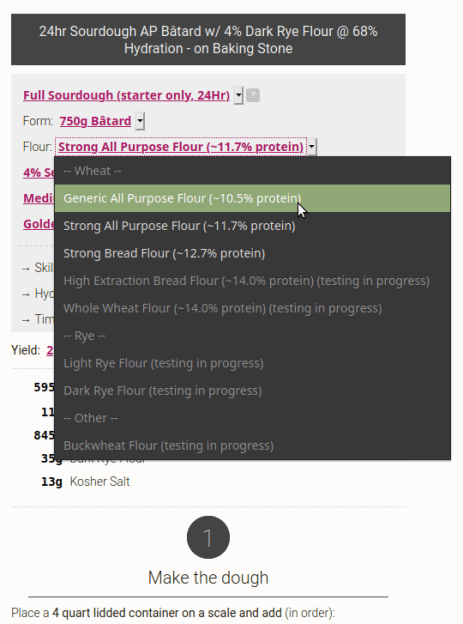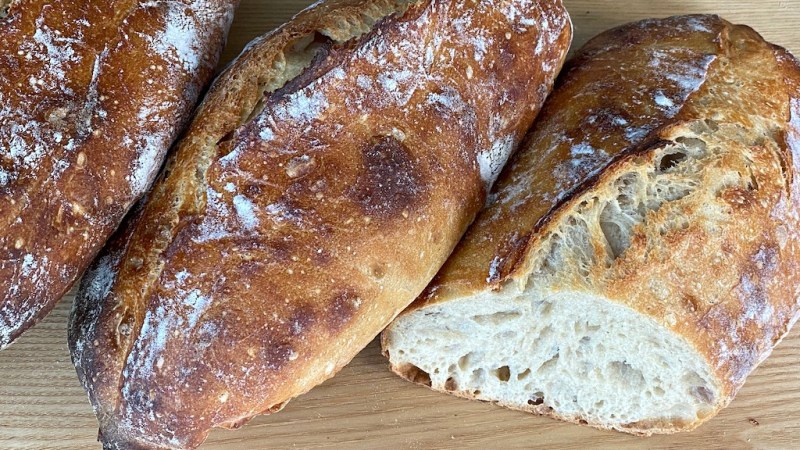More people are making sourdough at home than ever before, and while it may not take a lot of effort to find a decent recipe, it’s quite another thing to try using recipes to figure out how and why bread actually works. Thankfully, [Makefast Workshop] has turned copious research and hundreds of trials into a dynamic sourdough (and semi-sourdough) bread recipe chock-full of of drop-down options to customize not just ingredients, but baking methods and other recipe elements as well. Want to adjust quantities or loaf styles? Play with hydration or flour type? It’s all right there, and they even have quick-set options for their personal favorites.
 In order to do all this, [Makefast Workshop] needed to understand bread at a deeper level than is usually called for. During research, they observed that the format of recipes was often an obstacle to understanding how good bread actually gets made. The reason for this is simple: recipes are presented as standalone documents describing a fixed process; a set of specific steps that, when followed, yield a particular result. What they do not normally do is describe the interplay and balance between ingredients and processes, which makes it difficult to understand how and why exactly the recipe produces what it does. Without that knowledge, it’s impossible to know what elements can be adjusted, and how. The dynamic recipe changes all that.
In order to do all this, [Makefast Workshop] needed to understand bread at a deeper level than is usually called for. During research, they observed that the format of recipes was often an obstacle to understanding how good bread actually gets made. The reason for this is simple: recipes are presented as standalone documents describing a fixed process; a set of specific steps that, when followed, yield a particular result. What they do not normally do is describe the interplay and balance between ingredients and processes, which makes it difficult to understand how and why exactly the recipe produces what it does. Without that knowledge, it’s impossible to know what elements can be adjusted, and how. The dynamic recipe changes all that.
[Makefast Workshop] performed hundreds of tests, dialing in parameters one by one, to gain the insights needed to populate their dynamic recipe. It’s got clear processes and drop-down options that dynamically update not just the recipe steps, but also the URL. This means that one can fiddle the recipe to one’s desire, then simply copy and paste the URL to keep track of what one has baked.
When it comes to thoughtful approaches to food, this certainly isn’t [Makefast Workshop]’s first rodeo. We covered their beautiful directions for creating delicious speculoos, complete with effective 3D printed molds for a modern twist on a Belgian classic.
















Afaik protein is gluten so i´m buying cheapo standard flour and add gluten/seitan powder(also really cheap) to it – much much cheaper than buying high protein flour. Really nice for pizza aswell.
Would not really work the same with other protein sources. Gluten is indeed protein, but the way it forms longer chains during kneading is key to trap the gas inside that makes your bread grow. It wouldn’t work in the same way with soy protein. There is very cheap high-protein flour you can buy. If cost is your concern, you won’t beat buying cheap bread because of the electricity/gas costs of making it at home. If you go for quality, it depends if you consider it a chore or a hobby ;)
You can make your own gluten/seitan from just all purpose flour, you end up wasting a lot of starch, though.
I understand that some people might be more sensitive to cost, but I don’t get much why to put so much effort in shaving cents when trying to make good food.
I mean, here in Italy cheap all-purpose flour is maybe 0,50€ / kg, the fanciest is 2€ / kg.
With 1kg, you’re still making pizza for almost 10 people (I know, talking about how much we should eat, not how much we eat :D )
We’re not talking about a 100€ bottle of wine, it’s 5cents vs 20cents per meal…
I appreciate some people might be more cost sensitive than others, but personally I don’t get this approach.
At least in Italy where I live, cheap all-purpose flour is 0,5€/kg while the fanciest one is 2€/kg. Sure, it’s a 4x, but with 1kg of flour you are able (or supposed to be able…) to feed up to 10 people!
Come on, spend those extra cents and give me that full-taste expensive flour!
I know, I know, I’m Italian, don’t touch us our pizza :D
I don’t bother with getting high protein floor. I use all-purpose flour but what l do differently is that l cook some of that flour into a thick paste, let it cool and then incorporate it into the dough. (Google tangzhong method for explanation.)
I’ve got a simpler version of this in an Excel document. Been thinking about making it into a webapp, but seems that’s no longer necessary 😊
At first I thought the title was in error, but then I realized that matrization refers to unfolding tensors, which are objects that describe multilinear relationships between sets of other objects, and a recipe is a kind of a matrix of ingredients and amounts.
So yes, you are unfolding the complexity of making sourdough.
I see what you did there.
Strange to list autolyse after adding starter and yeast, as autolyse per definition is only wheat and water, nothing else.
True, but the protease and amylase get activated much quicker than the starter, I think you get time savings doing this in parallel as long as sugars are made available faster than they are consumed
… in fact, you can skip the autolysis altogether and the dough will still rise, so there is that.
I’ve seen it both ways many times, but the salt is usually added after the autolyse
Obligatory xkcd https://xkcd.com/2296/
Is there really no situation for which there isn’t a relevant xkcd?!
If a headline asks a question, the answer can be assumed to be “NO!”
Must you _always_ answer my rhetorical questions?
No.
Damnit! :)
+1
I use about 20x as much starter as they recommend, is that an error or does that really work?